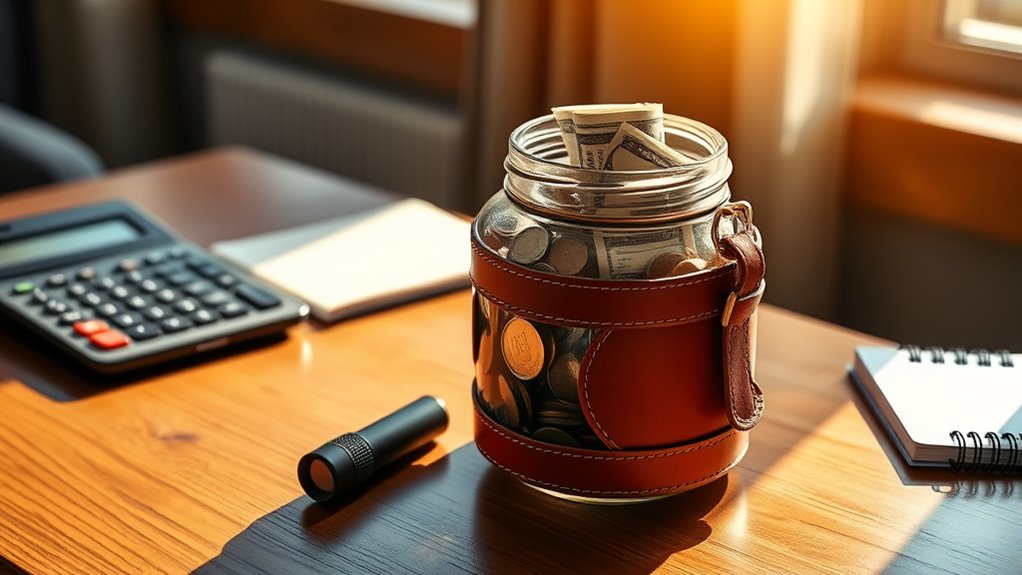An emergency fund is essential because it provides quick access to money during unexpected events like medical emergencies, job loss, or urgent repairs. It acts as a safety net, helping you avoid high-interest debt and maintain stability. With a well-funded emergency reserve, you’ll feel more confident and less stressed during tough times. Keep exploring to discover how to build and protect your emergency fund effectively.
Key Takeaways
- An emergency fund provides financial security during unexpected expenses or income loss.
- It reduces reliance on high-interest debt during emergencies.
- Having a fund ensures quick access to cash, minimizing delays and stress.
- An emergency fund enhances emotional resilience by lowering financial anxiety.
- It helps maintain overall financial stability amid unforeseen circumstances.
Understanding the Importance of an Emergency Fund
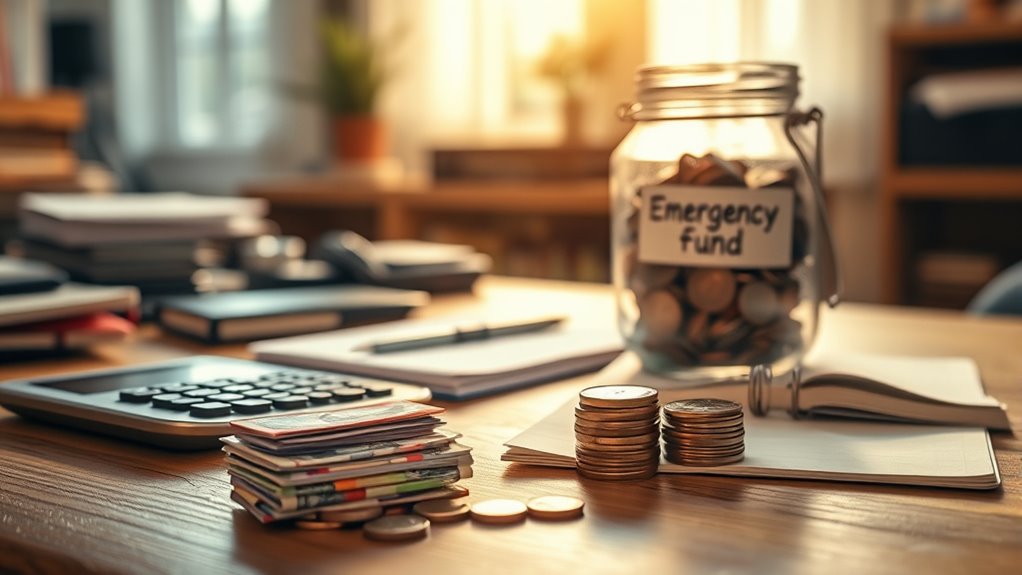
Having an emergency fund is essential because unexpected expenses can happen at any time, leaving you financially vulnerable if you’re unprepared. It’s a vital part of your financial planning strategy, helping you manage risks effectively. By setting aside money for emergencies, you reduce the stress that comes with sudden costs, like medical bills or car repairs. An emergency fund acts as a safety net, ensuring you don’t have to rely on high-interest loans or credit cards when surprises strike. It provides peace of mind, knowing you can handle unforeseen events without jeopardizing your financial stability. Building and maintaining this fund is a proactive step toward controlling your financial future and managing risks wisely. Understanding the different cookie categories used by websites can help you make informed decisions about online privacy and security.
Common Situations That Require Immediate Financial Support
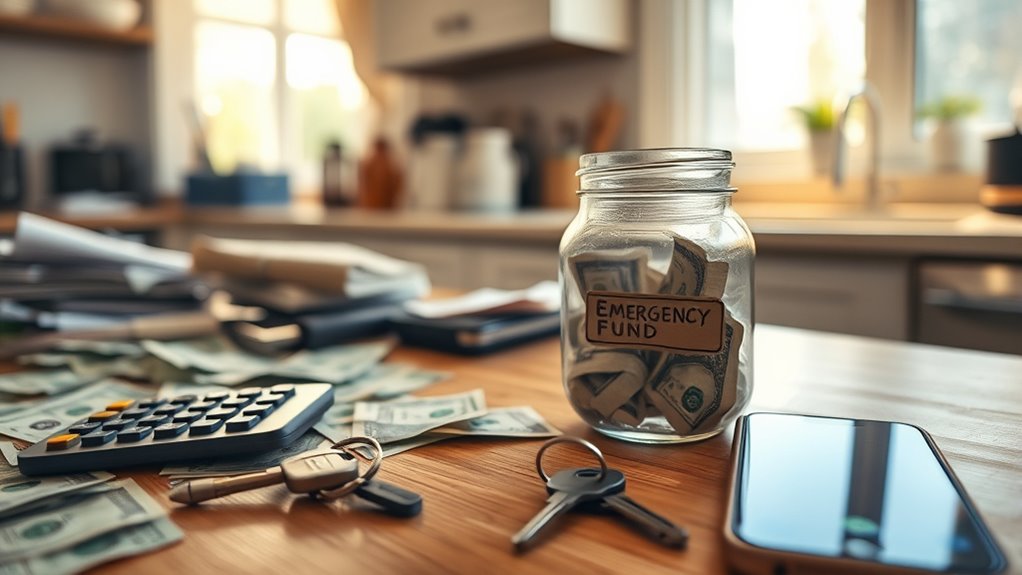
Unexpected expenses can strike at any moment, making it imperative to recognize situations that demand immediate financial support. Medical expenses, such as sudden injuries or illnesses, can quickly drain your resources if you’re unprepared. These costs often come unexpectedly, leaving little time to plan or save. Similarly, unexpected travel, like emergencies involving family or urgent work commitments, can incur hefty expenses that disrupt your finances. In both cases, having an emergency fund ensures you won’t have to borrow money or compromise your financial stability. Recognizing these situations helps you act swiftly, providing peace of mind during stressful times. Being prepared for medical expenses and unexpected travel is vital to managing life’s surprises without financial strain. Additionally, understanding how running dry can affect your physical and mental health highlights the importance of maintaining financial and personal resilience to navigate emergencies effectively.
How Much Money Should You Save for Emergencies
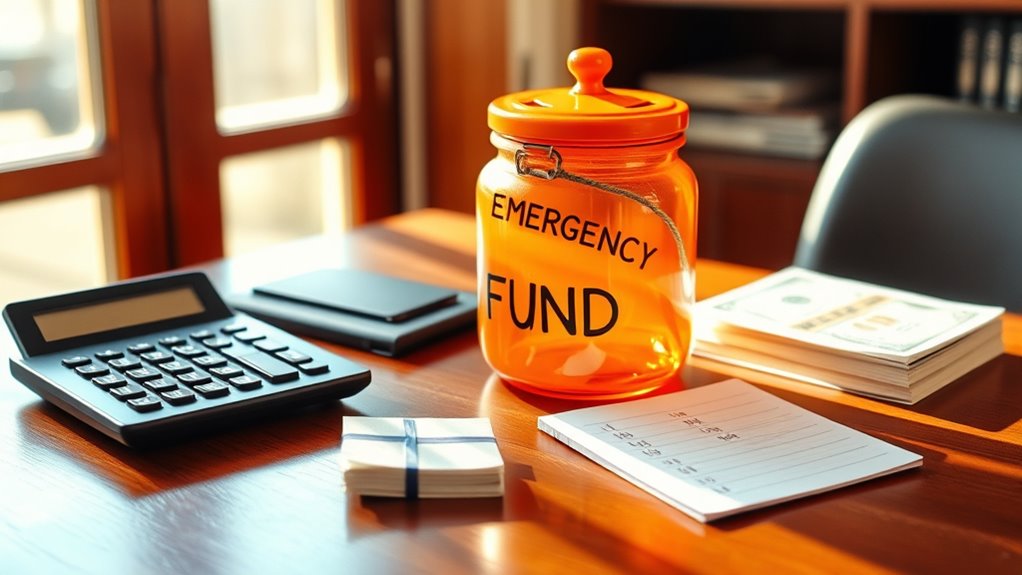
Determining the right amount to save for emergencies can seem challenging, but a good rule of thumb is to set aside enough to cover three to six months’ worth of living expenses. This amount provides a solid financial cushion if unexpected events occur, such as job loss or medical emergencies. When planning your savings, consider your income stability and essential expenses. Incorporating smart investment strategies can help your emergency fund grow faster, especially through high-yield savings accounts or low-risk investments. Effective financial planning guarantees you’re consistently contributing without jeopardizing your long-term goals. Remember, the ideal emergency fund is tailored to your personal circumstances, so reassess periodically to adjust for life changes or shifts in your financial situation.
The Benefits of Having a Financial Safety Net
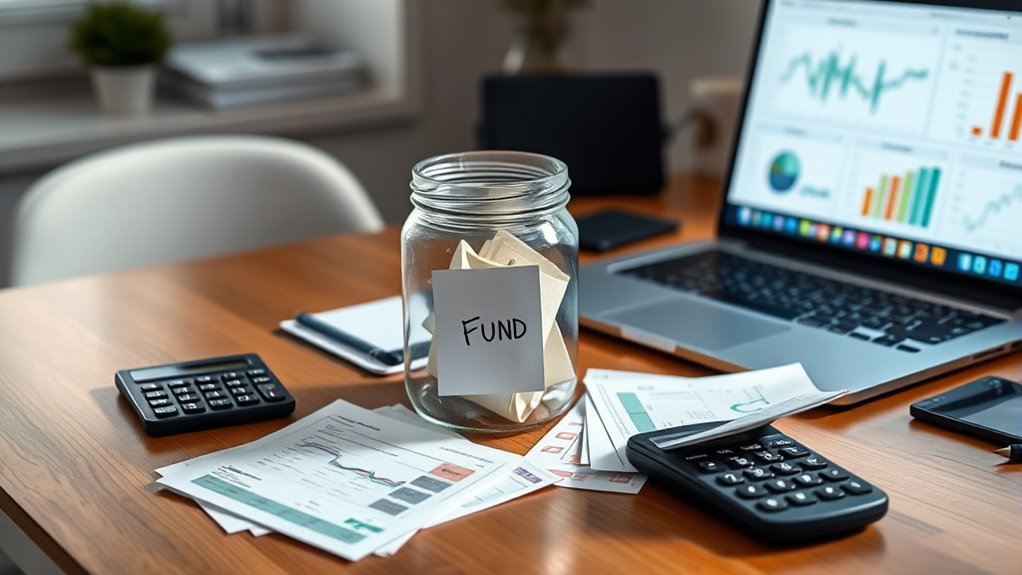
Having a financial safety net means you can access funds quickly when emergencies arise, preventing delays and stress. It also helps reduce financial anxiety by providing peace of mind during unexpected events. Plus, it keeps you from accumulating debt, protecting your long-term financial health. For example, understanding the importance of emergency fund can motivate you to start saving regularly.
Quick Access During Emergencies
Ever wondered how quickly you can handle a sudden financial crisis? Having an emergency fund guarantees you can access money instantly when unexpected expenses arise. Your financial literacy plays a vital role in recognizing the importance of emergency planning, which includes setting aside funds for urgent needs. With quick access to your savings, you avoid high-interest loans or credit card debt that can worsen your situation. An emergency fund acts as a safety net, giving you peace of mind and control during stressful times. By regularly reviewing and maintaining your fund, you guarantee it’s ready when needed most. This proactive approach helps you respond swiftly, minimizing the impact of unforeseen costs and keeping your finances stable. Additionally, understanding financial security is crucial in appreciating how an emergency fund supports overall stability.
Reduces Financial Stress
When you have an emergency fund in place, it considerably eases the burden of unexpected expenses. Knowing you have savings set aside reduces the anxiety that comes with sudden financial surprises. This safety net boosts your financial literacy by encouraging you to understand your spending habits and prioritize savings. Implementing effective budgeting strategies helps you build and maintain your fund, giving you peace of mind. Instead of worrying about how to cover an emergency, you can focus on managing your daily expenses confidently. Having a financial safety net helps you stay calmer during stressful times, preventing panic and impulsive decisions. Additionally, having an emergency fund supports overall financial stability, which is essential for lifestyle for longevity. Ultimately, it provides emotional stability, making your overall financial life more secure and less overwhelming.
Prevents Debt Accumulation
A solid emergency fund acts as a financial barrier that prevents you from falling into debt when unexpected expenses arise. Without it, you might rely on credit cards, escalating your debt quickly. Here’s how an emergency fund helps you avoid debt:
- It covers urgent costs like medical bills or car repairs, so you don’t need to use high-interest credit cards.
- Savings automation makes building this fund effortless, ensuring consistent growth without extra effort.
- Having cash readily available reduces the temptation to borrow or rack up debt during emergencies.
- Additionally, having a high‑end home appliance like a smart air purifier can help prevent health-related emergencies, further protecting your finances.
Strategies for Building Your Emergency Fund Quickly

To build your emergency fund quickly, you need to focus on increasing your savings rate and reducing expenses. Start by applying effective budgeting techniques, tracking your spending, and cutting unnecessary costs. Automate transfers to a dedicated savings account to make saving effortless. Consider using investment strategies, like high-yield savings accounts or short-term bonds, to grow your fund faster. Prioritize your emergency fund as a financial goal and allocate extra income, such as bonuses or side hustle earnings, toward it. Avoid impulsive purchases and review your budget regularly to identify areas for improvement. Staying disciplined and committed will accelerate your progress, ensuring you’re prepared for unexpected expenses without relying on debt. Incorporating sound healing science principles can also help reduce stress and maintain focus while managing your finances. These strategies help you build your emergency fund efficiently and effectively.
Tips for Maintaining and Growing Your Savings

Maintaining and growing your savings requires consistent effort and strategic planning. To do this effectively, consider these key steps:
- Diversify your investments to reduce risk and increase potential returns, aligning with your overall financial planning.
- Automate your savings to guarantee regular contributions, making it easier to build your fund over time.
- Review and adjust your investment strategies periodically, keeping pace with your changing financial goals and market conditions.
Mistakes to Avoid When Creating Your Emergency Fund

While growing your savings is important, many people make common mistakes when creating an emergency fund that can undermine their efforts. One mistake is diverting money into risky investment opportunities, which can reduce your accessibility during emergencies. Avoid using these funds for long-term investments like retirement planning until your emergency fund is fully established. Another error is setting an unrealistic savings goal or delaying start, leaving you unprepared when unexpected costs arise. Additionally, neglecting to keep your emergency cash in a liquid, easily accessible account can cause delays in access when urgent needs occur. Failing to regularly review and adjust your savings plan can also hinder progress. Being aware of paint sprayer performance metrics and choosing the right equipment can help prevent unexpected expenses and ensure your savings are available when needed. By steering clear of these mistakes, you ensure your emergency fund serves as a reliable safety net when you need it most.
Where to Keep Your Emergency Cash for Accessibility and Security

You need to choose a place for your emergency cash that’s both easy to access and safe from theft. An accessible savings account offers quick withdrawal, while a secure physical location, like a safe, keeps cash protected at home. Avoid investment risks that could cause your funds to lose value when you need them most. Additionally, consider the importance of special occasions in providing guidance on maintaining a balanced and resilient approach to financial planning.
Accessible Savings Accounts
Are you wondering where to keep your emergency cash so it’s both accessible and secure? The best option is an accessible savings account. To choose the right one, consider these key factors:
- Interest rates – Look for accounts offering higher rates to help your savings grow faster.
- Bank fees – Avoid accounts with high fees that can eat into your emergency fund.
- Accessibility – Ensure you can easily withdraw funds without penalties during an emergency.
A high-yield savings account often balances good interest rates with low fees. Keeping your emergency cash in a dedicated, accessible savings account ensures you’re prepared without compromising security or growth potential. Additionally, understanding how automation in business enhances operational efficiency can help you select banks that leverage innovative technology for better service.
Secure Physical Locations
Choosing a physical location for your emergency cash requires careful consideration to guarantee it’s both accessible and secure. A safety deposit box at your bank offers secure storage, protecting your funds from theft or damage. Keep in mind, however, that access might be limited during emergencies or bank hours. Alternatively, a hidden, secure spot in your home—such as a lockbox or a discreet container—can provide quick access when needed. Whichever option you choose, ensure it’s well-concealed and only known to you or trusted family members. Avoid obvious places to prevent theft, but also ensure you can retrieve the cash promptly during urgent situations. Balancing security with accessibility is key to making your emergency cash both safe and readily available when it matters most.
Avoid Investment Risks
To guarantee your emergency cash remains safe and accessible, avoid investment options that carry significant risks or market volatility. You want your funds to be reliable when emergencies strike, not subject to sudden losses. Focus on accounts that prioritize security and liquidity. Consider these options:
- High-yield savings accounts for steady growth and easy access
- Money market accounts offering minimal risk and quick withdrawals
- Certificates of deposit (CDs) with short terms to lock in fixed rates
Avoid risky investments that involve investment diversification strategies or market volatility, as these can jeopardize your emergency fund’s stability. The goal is to preserve your principal and ensure readiness when needed, not chase high returns that could disappear overnight. Keep your emergency cash in low-risk, accessible places for peace of mind and financial security.
How an Emergency Fund Can Reduce Stress and Financial Anxiety

Having an emergency fund in place can considerably ease your mind during unexpected financial setbacks. Knowing you have a safety net reduces anxiety and helps you maintain emotional resilience. When you’re financially literate, you understand how to manage funds effectively, which further lowers stress. An emergency fund offers peace of mind by providing quick access to cash, preventing panic during crises. Here’s why it matters:
| Benefit | Impact | Key Point |
|---|---|---|
| Reduced Anxiety | Less worry about unforeseen expenses | Confidence in your financial stability |
| Emotional Resilience | Bouncing back from setbacks | Staying calm during emergencies |
| Financial Literacy | Better money management skills | Making informed decisions |
| Peace of Mind | Feeling secure in uncertain times | Less stress in daily life |
| Stress Reduction | Overall emotional well-being | Improved mental health |
Steps to Take Once Your Emergency Fund Is Fully Funded
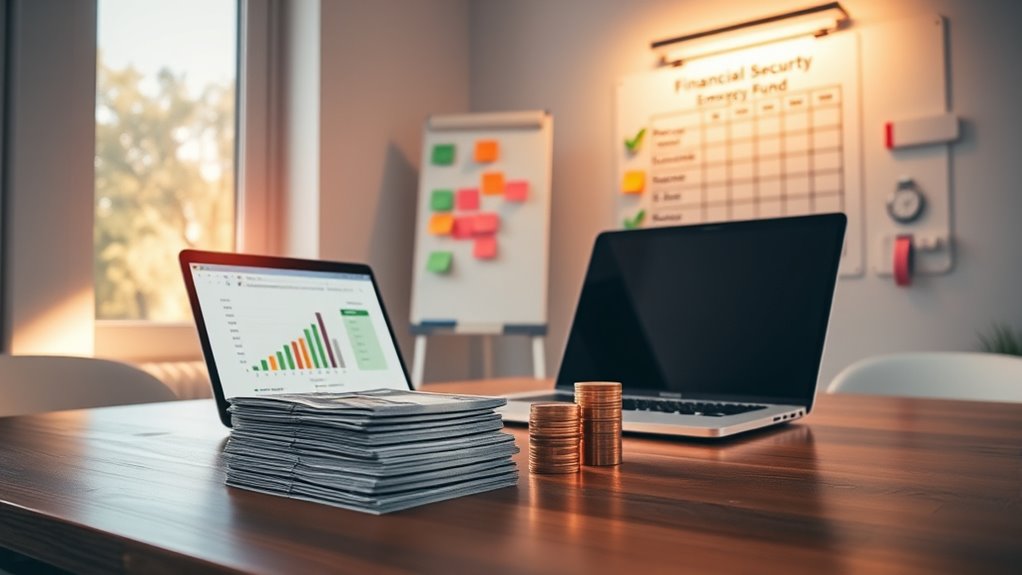
Once your emergency fund is fully funded, it’s time to reassess your savings goals to guarantee they still align with your financial plans. Keep your fund accessible so you can use it quickly if needed, but also consider planning future investments to grow your wealth. Staying proactive helps you make the most of your financial security and prepares you for upcoming opportunities.
Reassess Savings Goals
What’s next after fully funding your emergency fund? It’s time to reevaluate your savings goals. This guarantees your financial plan stays aligned with your current priorities. Start with these steps:
- Perform a budget review to identify new expenses or savings opportunities.
- Adjust your goal amounts based on evolving needs, like upcoming large purchases or financial milestones.
- Set new targets for additional savings, such as investing or retirement contributions.
Maintain Fund Accessibility
After fully funding your emergency fund and updating your savings goals, it’s important to guarantee that this money remains easily accessible when you need it. Keep your emergency fund in a liquid, low-risk account like a high-yield savings account or money market fund. Avoid locking it into long-term investments, which can hinder quick access during emergencies. Maintaining immediate access to your funds is essential for effective investment planning and protecting your retirement savings from unexpected expenses. Regularly review your account to ensure it still offers the flexibility you need, and avoid using these funds for non-emergencies. By doing so, you safeguard your emergency fund’s purpose, making sure it’s ready when unforeseen expenses or urgent situations arise.
Plan Future Investments
With your emergency fund fully in place, you can shift your focus toward strategic investments that help grow your wealth. To make the most of this opportunity, consider these steps:
- Prioritize retirement planning by contributing to tax-advantaged accounts like IRAs or 401(k)s, maximizing your savings potential.
- Be aware of tax implications when investing, choosing options that offer favorable treatment and minimizing unnecessary liabilities.
- Diversify your investments across stocks, bonds, and real estate to balance risk and growth potential.
Frequently Asked Questions
How Often Should I Review and Adjust My Emergency Fund?
You should review your emergency fund regularly, ideally with a monthly review, to guarantee it still meets your needs. Life changes, like a new job or increased expenses, may require emergency fund adjustments. Keep an eye on your financial situation and make adjustments as needed. This way, you’re always prepared for unexpected expenses, and your emergency fund remains a reliable safety net.
Can I Use My Emergency Fund for Non-Emergency Expenses?
Imagine you use your emergency fund for a non-emergency expense, like a vacation. This is a classic case of emergency fund misuse. While it might seem tempting, your emergency fund is meant for unexpected events like job loss or medical bills. Using it for non-emergency expenses leaves you unprepared for real emergencies. Keep your fund intact, so when genuine needs arise, you’re ready to handle them without stress.
What’S the Best Way to Start Saving if I Have Debt?
If you’re saving while carrying debt, start with a debt snowball to pay off smaller debts first, freeing up extra cash. Simultaneously, set up savings automation so a portion of your income automatically goes into a dedicated savings account. This approach keeps you disciplined, reduces your debt faster, and gradually builds your emergency fund, ensuring you’re protected without neglecting your financial goals.
How Do I Prioritize Building an Emergency Fund Versus Other Financial Goals?
So, you’re wondering whether to build an emergency fund or chase other financial milestones first? Ironically, having a solid emergency fund actually helps you reach those goals faster. Focus on budget planning to allocate a small portion of your income toward an emergency stash. Once you have a safety net, you’ll find it easier to pursue bigger goals without stress. Prioritizing this fund makes all your dreams more achievable.
Should I Include Irregular Income Sources When Calculating My Emergency Savings?
When calculating your savings, including irregular income sources can give you a more accurate picture of your financial needs. Irregular income varies month to month, so factoring it into your savings calculation guarantees you’re prepared for lean periods. You should consider your average income from these sources and add a buffer to cover expenses. This way, your emergency fund truly reflects your financial situation and offers better protection.
Conclusion
Having an emergency fund is like building a safety net beneath your financial tightrope. It gives you peace of mind, ready to catch you when life throws unexpected surprises your way. Start small, stay consistent, and watch your safety net grow stronger each day. Remember, the sooner you build it, the quicker you’ll bounce back from setbacks. Your future self will thank you for having this financial cushion to keep you steady through life’s storms.
